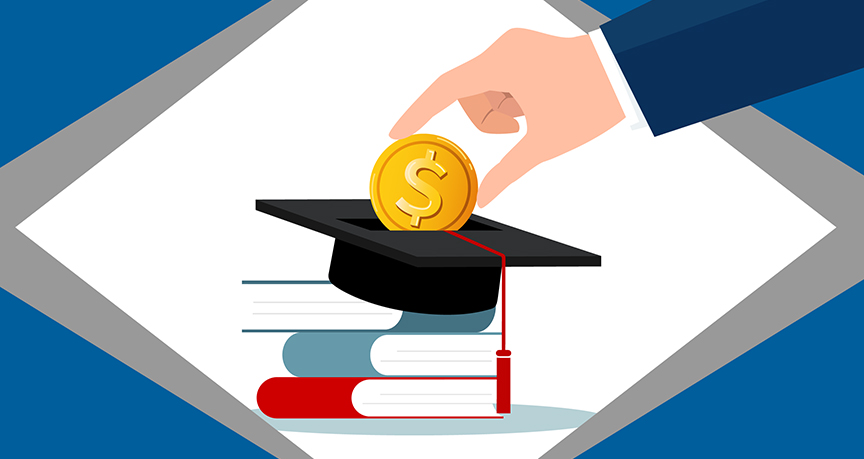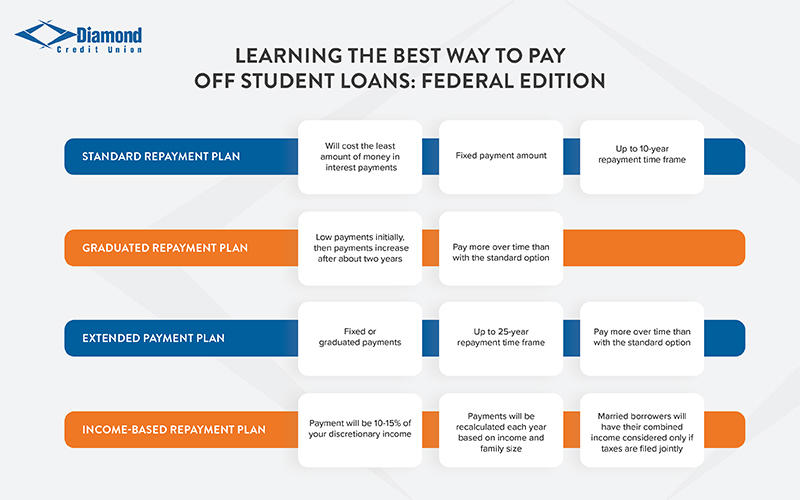
Learning the Best Way to Pay Off Student Loans
If you feel overwhelmed by your student loans, you’re not alone. In 2024, 42.7 million people had federal student loan debt.
While consistent monthly payments seem like the straightforward approach to student loan repayment, it’s worth asking if you’re maximizing your repayment. There are often overlooked aspects that can significantly impact your repayment timeline and overall cost.
Whether you’re in the middle of a student loan repayment strategy or approaching the end of your grace period and wondering how to tackle your loans, we’ve provided some tips for the best way to pay off student loans.
First Know Your Debt: Private Student Loans vs Federal Loans
Before you can create a student loan repayment strategy, you need to assess your current student loan situation. Begin by figuring out your total debt and what types of loans you have.
Are they federal loans vs private loans, or do you have a combination of both? If you have federal loans, the National Student Loan Data System (NSLDS) provides a complete overview of your debt. However, if you have private loans, you must contact each lender to get your balances and repayment details.
Quick Summary: Federal Student Loans
Federal student loans are offered by the U.S. Department of Education to help students finance their higher education. There are three types of loans:
- Direct Subsidized Loans: Available to undergraduates demonstrating financial need, these offer the benefit of the government covering interest accrual during in-school periods.
- Direct Unsubsidized Loans: Accessible to both undergraduate and graduate students, these accrue interest from the time of disbursement.
- Direct PLUS Loans: Catering to graduate/professional students and parents of undergraduates, these require a credit check for eligibility.
Federal student loans provide numerous advantages, including generally lower, fixed interest rates and flexible repayment plans, such as income-driven options. Borrowers also benefit from deferment periods and potential eligibility for loan forgiveness programs.
Quick Summary: Private Student Loans
Private student loans are through private lenders, such as banks, credit unions, and online financial institutions, to help students cover their higher education expenses. A major difference between federal loans vs private loans is that private student loans depend more on the borrower’s, or if the student has limited or no credit history, the cosigner’s creditworthiness.
Interest rates on private student loans can be either fixed or variable, and they generally tend to be higher than those offered by federal loan programs. These rates fluctuate depending on the borrower’s credit score and the specific lender’s terms. Repayment terms also vary considerably between lenders, and these loans typically offer less flexible repayment options compared to federal loans.
Also, private student loans lack the federal protections given to federal borrowers, such as income-driven repayment plans and loan forgiveness programs. So, it’s generally recommended to look at all federal loan options before considering private student loans.

Choose the Right Federal Student Loan Repayment Plan
For federal student loans, including Stafford, Perkins, PLUS, and Direct Consolidation, there are several repayment plans to choose from.
Oftentimes, you will be assigned a repayment plan, but you have the freedom to change your repayment plan at any time with absolutely no cost associated. Consider each option and apply it to your personal situation. Just because a repayment plan has the lowest monthly payment, doesn’t necessarily mean it’s the best choice. This option might mean paying a significant amount of interest over the life of the loan.
The following are the most common:
1. Standard Repayment Plan
This is the default option for federal student loans unless you choose a different repayment method. It’s designed to minimize the total interest paid over the lifetime of the loan. It features a fixed monthly payment and a 10-year repayment time frame, which allows you to create a consistent monthly budget.
By keeping a fixed payment schedule and a relatively short repayment window, you’ll pay less overall than those who opt for extended or income-driven repayment plans.
2. Graduated Repayment Plan
A graduated repayment plan is a different approach to the standard payment plan. It starts with lower initial payments, and then the payments increase after about two years. This plan is suited for people whose career has a lower starting salary but is likely to see steady income growth.
While this plan provides immediate relief, you pay more over time in interest than with the standard option.
3. Extended Payment Plan
The extended repayment plan offers flexibility with either fixed or graduated monthly payments and a repayment timeframe of up to 25 years. This extended timeframe leads to significantly higher interest accumulation compared to the standard 10-year plan.
However, if you would rather have lower, predictable monthly payments, to work better with an hourly wage, the extended plan offers a manageable solution.
4. Income-Driven Repayment Plan
With an income-driven repayment plan, your monthly payment will be based on how much money you earn and your family size. This means your payment amount will fluctuate based on your financial situation.
Typically, payments are usually about 10% of your discretionary income and are recalculated annually to account for any changes in your income or family size. For married borrowers, the calculation considers the combined income of both spouses, reflecting the household’s overall financial capacity.
There are four income-driven repayment plans:
- Saving on a Valuable Education (SAVE) Plan—formerly the REPAYE Plan)*
- Pay as You Earn Repayment (PAYE)
- Income-Based Repayment Plan (IBR)
- Income-Contingent Repayment Plan (ICR)
*As of March 2025, a federal court injunction issued in the spring of 2024, preventing parts of the SAVE program from being implemented, is in place.
A significant feature of these plans is the potential for loan forgiveness. After making qualifying payments for 20 to 25 years, any remaining loan balance may be forgiven. These repayment options are especially beneficial for individuals with a high debt-to-income ratio, providing a more manageable payment structure that aligns with their earnings.
Repaying Private Student Loans
Unlike federal student loans, private loans are not subsidized by the federal government. They are funded by credit unions, banks, or other lenders. The rates, as well as the loan limits and terms, are set by the lender.
The rates are generally higher than those offered through federal loans, and the terms and limits are less flexible. If you happen to fall behind on your loan, private lenders generally don’t offer program resources to help you re-establish your footing.
Because of this, we recommend communicating with your lender in the event you are unable to meet your financial obligations. Be sure to review your private student loan contracts carefully, making sure you are aware of what you are agreeing to and the rights you have.
Since private loans have higher interest rates and are less forgiving, we recommend paying these off first.
Focus On High Interest and/or Variable Interest Loans First
Should you consider paying off some of your loans in advance? If so, one of the best tips for paying off student loans is to start with the ones that have the highest rate. Keep in mind that unsubsidized loans will accrue interest throughout your repayment grace period. When your grace period ends, that accrued interest is added to your principal, increasing your debt. You don’t need to pay off that interest until your grace period ends, but it will be adding up and if you can afford to, why not focus on knocking out that interest?
Additionally, loans with a variable interest rate should be paid off as quickly as possible. Even if the interest rate is lower than your fixed-rate loans, the rate could change in the blink of an eye. When the economy improves, interest rates go up, causing your monthly payments to increase with little forewarning.
Go Beyond the Bare Minimum
If your finances allow it, plan to pay more than the minimum balance on your student loans, or even two payments per month instead of one. This is one of the best student loan debt repayment strategies to pay your student loans in full sooner than originally anticipated. Online loan calculators allow you to test different payment scenarios to see what paying extra will do for you long-term.
Generally, your lender will apply the extra amount first to accrued interest that wasn’t covered by your monthly payment, then towards the principal balance. However, it is beneficial to have that amount go towards your principal balance. The more you put towards your principal balance, the less interest you will have to pay over time. It is best to contact your lender directly to let them know where you want the extra amount to go.
To Consolidate or Not to Consolidate
When consolidating your student loans, you are combining multiple loans into one so you can make a single monthly payment with one interest rate. This can be enticing since it makes repayment seamless, with one bill to focus on instead of multiple bills.
Try to avoid consolidating federal loans into a private loan because you will lose your choice of repayment options and the benefits associated with federal loans (which are more flexible).
Also, keep in mind that consolidation limits the student loan debt repayment strategies mentioned above, like aggressively paying private loans initially or focusing on high-interest rate loans first. Once loans are consolidated, you can’t be as strategic as before.
Selecting a Student Loan Repayment Strategy
If you’re still unsure about the best way to pay off student loans, reach out to Diamond’s HERO Financial Counselors. These representatives are certified and have completed training so that they can provide you with advice to reach your financial goals. Schedule an appointment here.

